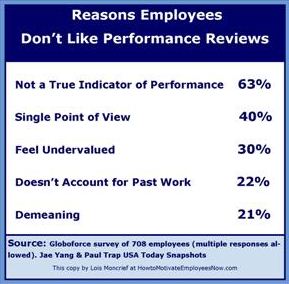5 Tips to Improve Performance Reviews (and Employee Motivation at the same time)
Recently USA Today Snapshots posted the Top Reasons Employees Dislike Performance Reviews. I have taken that information and put it in the following image for you.
Most of you have just completed performance reviews for your employees as we are near the end of the calendar year.
Today I am going to cover 5 ways you can improve employee performance reviews for next year based on the USAToday Snapshot results.
First, I am going to cover what YOU can do to have a better outcome that does not mean that every employee will be more satisfied. There are some who will never be satisfied but you can still do your part to improve the outcome. I am not going to cover every thing you can do today. I am only addressing items in the above chart.
How to Turn Your Employees into Champions – 12 Tips for Giving Feedback
Tip # 1 – Dislike #1 Not a True Indication of Performance
If the review was less than the employee expected then this is a natural reaction. It is possible it does not truly reflect his performance. It is possible he is unrealistic about his performance. Here is what you can do for next year to reduce the validity of his dislike.
Follow the SMART (Specific, Measurable, Attainable, Relevant, and Time bound) guidelines for creating your performance standards.
Make sure as much as possible that the standards are objective rather than subjective. If you must use subjective then give guidelines about what will exceed, meet, and fail the standard.
Meet with the employee monthly if possible to assess his progress in meeting the annual goals. Give him the opportunity to provide examples of his work for your records. This is especially helpful if you run a large organization and may not be aware of everything he has done that is relevant to the performance standards.
Give him feedback on his progress – include tips for improvement and help if needed. This gives him the opportunity to see his progress and understand what he needs to do to improve so there are no surprises of a less than expected performance review at the end of the year.
Employee motivation increases when they understand better what you want them to do and how well you want them to perform.
Tip 2. Dislike # 2 – Single Point of View
You may have options here. You may choose to remain as the single point of view (the only one giving him a performance review) if so the more you can tie the review to objective performance standards the less it is “just your view”. It is his performance being judged against standards that include productivity, timeliness, and quality for example. It is his performance record not your view.
If you choose to rely on standards that are subjective and vague then you open yourself up to this criticism. If you must use subjective standards then give examples of what would exceed, meet, or fail so the employee knows what is expected of him.
Another option is to go to the 360 approach where other managers and his peers submit their evaluation of his performance to you to combine into a final evaluation. This requires extra work on your part for gathering information and collating it into a final performance evaluation.
This can become time consuming and more difficult to manage as everyone involved may not have all the information on his performance that you do. It can also create additional problems as the employee wants to know who said that about him.
NOTE: Some managers prefer to keep performance standards vague as they want to leave themselves a lot of leeway for “their opinion” – after all they are the manager and “know” their employees.
This is a position that may give satisfaction in the short term but is very costly in the long run.
Managers win when their employees perform.
Employees are not dumb. They will not continue to perform in a no win situation. If the target keeps moving or is always unattainable they probably will give up and leave or become disengaged, unmotivated and under performing and then the manager has lost.
Tip # 3 – Dislike # 3 Feel Undervalued
Your best response to this to ensure the employee understands what you expect and then the ball is in his court to perform. If he has not performed to exceed the standards then that should be easy for you to show. If he thinks he has done more that you are not giving him credit for, give him the chance to submit additional information and records to show that.
Tip #4 – Dislike # 4 Doesn’t Account for Past Work
If this means continue to give him credit for what he did 2 yrs ago. No. You already gave him credit and paid him. This yearly evaluation is for work completed in this year.
Tip # 5 – Dislike #5 Demeaning
Always start performance reviews with thanks for what he did right and well. Always emphasize that you and the employee are in a partnership. You are successful when he is successful. Emphasize that you want to work with him to improve his success by giving him reasonable training and tips to be more successful BUT he has to do the work!
The performance review can be an opportunity for you and the employee to make sure he understands how to achieve greater success in the coming year. That in itself will increase his motivation.
If he is an employee who isn’t willing to do what you need then show him the door.

Post a Comment for "5 Tips to Improve Performance Reviews (and Employee Motivation at the same time)"